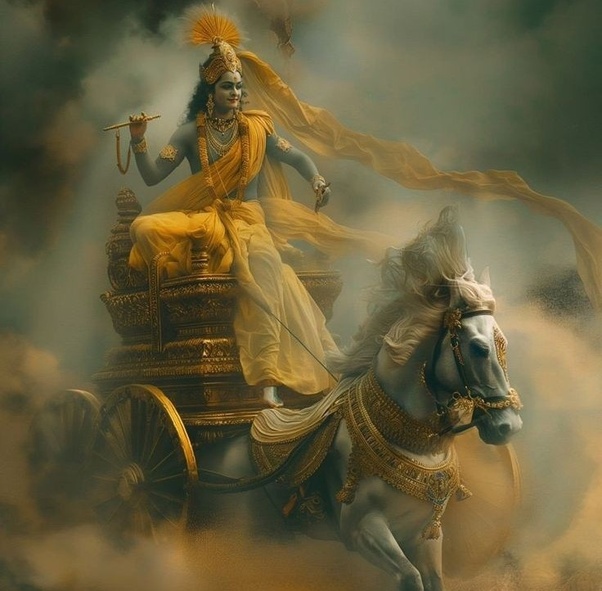In the epic Mahabharata, Lord Krishna’s chariot occupies a special place of reverence and awe. It was not merely a means of transport but a divine vehicle symbolizing Krishna’s supreme prowess and glory. The chariot, crafted with celestial precision and splendor, was drawn by four extraordinary horses: Sainya, Sugriva, Meghapushpa, and Balahaka. These horses were not ordinary steeds but celestial beings with immense strength, speed, and radiance.
The Four Divine Horses
The Mahabharata describes these horses in vivid detail, emphasizing their roles in magnifying Krishna's divine presence:
Sainya: Positioned on the right side, Sainya was known for its unmatched vigor and unyielding loyalty. Its name translates to "warrior," symbolizing its readiness for battle.
Sugriva: Positioned on the left, Sugriva was a harbinger of strength and courage. Its name means "one with a beautiful neck," possibly alluding to its noble stature and elegance.
Meghapushpa: Literally translating to “cloud-flower,” Meghapushpa was yoked on one of the flanks. It was swift and as gentle as a blooming flower yet as powerful as storm clouds.
Balahaka: The other flanking horse, Balahaka, was renowned for its sheer power and speed. Its name signifies "strength" or "force," embodying the chariot’s unstoppable momentum.
These divine steeds were bathed and adorned with the finest harnesses, enhancing their celestial beauty and power. Together, they formed an invincible team, carrying Krishna into the thick of battle, where their presence instilled both fear and wonder.
The Chariot of Lord Krishna
Krishna’s chariot, as described in the Mahabharata, was no ordinary vehicle. It was radiant like the rising sun and imbued with celestial energy. The shaft gleamed with the hues of dawn, and atop it fluttered the banner of Garuda, the king of birds and Krishna’s eternal companion. This banner was a symbol of victory and divine protection.
The roar of Krishna's chariot, amplified by the neighs of these divine horses, struck terror into the hearts of his enemies while inspiring awe and devotion among his allies.
Passages from the Mahabharata
The Mahabharata vividly captures the grandeur of Krishna’s horses and chariot:
"With Keshava’s permission, Daruka yoked the chariot, which was like the fire or the sun, and made Shini’s grandson ascend it. It could go wherever one wished and it was drawn by Sainya, Sugriva, Meghapushpa, and Balahaka. It possessed great speed and was decorated with gold." (Ghatotkacha Vadha Parva, Mahabharata 1099)
"The shaft of that excellent chariot had the complexion of the rising sun. Sainya was yoked on the right and Sugriva was yoked on the left. Meghapushpa and Balahaka were yoked on the flanks." (Aishika Parva, Mahabharata 1296)
Symbolism of the Horses
Each of Krishna’s horses represents qualities essential for achieving victory in life:
- Sainya signifies preparedness and valor in the face of challenges.
- Sugriva embodies resilience and grace under pressure.
- Meghapushpa represents the balance between gentleness and strength.
- Balahaka symbolizes unstoppable force and determination.
Together, they illustrate the harmony of divine qualities required to succeed in the cosmic battle of life.
Conclusion
The four horses of Lord Krishna’s chariot—Sainya, Sugriva, Meghapushpa, and Balahaka—are immortalized in the Mahabharata as celestial beings of unparalleled might and beauty. Their association with Krishna, the divine charioteer, enhances their sanctity and reminds us of the power of divine grace. The chariot they drew was not just a vehicle but a symbol of Krishna’s supreme guidance and the eternal truth he embodied

Comments
Post a Comment